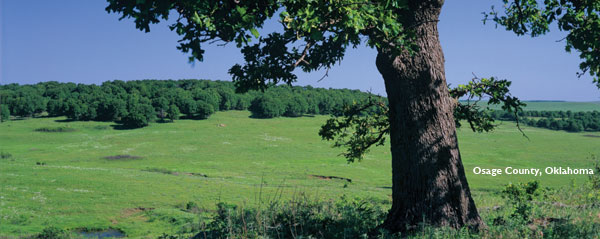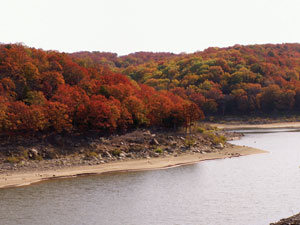|
back Home Cross TimbersGateway from forest to prairie Biodiversity of Oklahoma series |
|
The Cross Timbers Ecoregion
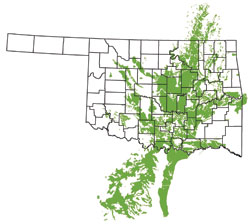 The
woodlands of central Oklahoma are the transition from our eastern
forests to the western prairies. These woodlands, known as the
Cross Timbers, are a mosaic of thick forest, open woodland, and prairie
patches. Of Oklahoma’s 12.7 million acres of forest land, about 4
million acres are in the Cross Timbers. The
woodlands of central Oklahoma are the transition from our eastern
forests to the western prairies. These woodlands, known as the
Cross Timbers, are a mosaic of thick forest, open woodland, and prairie
patches. Of Oklahoma’s 12.7 million acres of forest land, about 4
million acres are in the Cross Timbers.What Makes Up the Cross Timbers? A complex mosaic of upland deciduous forest, savanna, and prairie, the Cross Timbers spreads across central Oklahoma north into Kansas and south into Texas. Post oak, blackjack oak, and black hickory dominate the Cross Timbers, with blackjack becoming 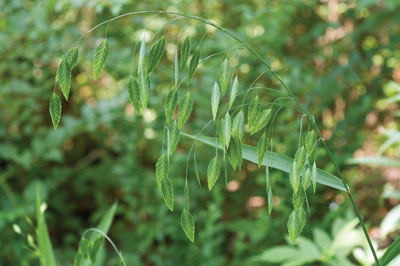 more common in the west – making a healthy Cross Timbers stand look
different in eastern Oklahoma as compared to central and western
portions of the state. Beneath and between trees, a diversity of
other plants flourish. Understory trees, such as roughleaf
dogwood and redbud, bloom beneath the canopy. Low shrubby plants
like buckbrush and fragrant sumac provide habitat and food for small
wil
dlife species. A variety of grasses and wildflowers that are
typical of the prairie will thrive in the sunny gaps between trees.
Indian grass, big bluestem, coneflowers, and Indian blanket shoot up
where sunlight is abundant.
more common in the west – making a healthy Cross Timbers stand look
different in eastern Oklahoma as compared to central and western
portions of the state. Beneath and between trees, a diversity of
other plants flourish. Understory trees, such as roughleaf
dogwood and redbud, bloom beneath the canopy. Low shrubby plants
like buckbrush and fragrant sumac provide habitat and food for small
wil
dlife species. A variety of grasses and wildflowers that are
typical of the prairie will thrive in the sunny gaps between trees.
Indian grass, big bluestem, coneflowers, and Indian blanket shoot up
where sunlight is abundant.
Because this forest type holds limited commercial va lue for timber production, it has not experienced large-scale industrial logging. Siza ble tracts of old growth post oak and blackjack oak forests are still found in many parts of Oklahoma with trees as old as 400 years. In spite of their age, the trees average only 15 to 40 feet tall and 5 to 20 inches in diameter. A Little History of the Cross Timbers What is Happening to the Cross Timbers The Cross Timbers woodlands have changed since Irving visited Oklahoma Territory. Cross Timbers forests developed over many centuries and are sensitive to change, especially such large-scale modifications as road construction and urban development. Fragmentation of the Cross Timbers occurs when we convert forest to agriculture lands, build new housing, and develop oil and gas resources, all of which impact wildlife habitat as well as watershed health. 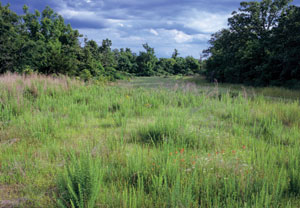 Also,
the Cross Timbers is being taken over by invasive species. Exotic
species from Asia and Europe are displacing our native plants and
changing the nature of our forests. Chinese privet and Japanese
honeysuckle are some of the most abundant invaders in the Cross
Timbers. Although a native tree, the eastern redcedar has
overtaken many acres of Cross Timbers because of fire suppression and
passive land management. Also,
the Cross Timbers is being taken over by invasive species. Exotic
species from Asia and Europe are displacing our native plants and
changing the nature of our forests. Chinese privet and Japanese
honeysuckle are some of the most abundant invaders in the Cross
Timbers. Although a native tree, the eastern redcedar has
overtaken many acres of Cross Timbers because of fire suppression and
passive land management. Why Should the Cross Timbers Matter to You?  The
Cross Timbers may not be commercial forests that provide high-quality
wood products, but they still offer many benefits and values to our
state that citizens might not realize. The
Cross Timbers may not be commercial forests that provide high-quality
wood products, but they still offer many benefits and values to our
state that citizens might not realize. Changes in the forest disrupt established natural processes within forest systems and affect the services they provide, including flood prevention, soil protection, wildlife habitat, and water filtration. When services provided naturally by forests are lost, they must be provided artificially, often at great public expense. Well-managed Cross Timbers can support healthy watersheds capable of filtering water and maintaining sustainable water supplies. Healthy Cross Timbers can decrease soil erosion problems and slow storm water runoff. 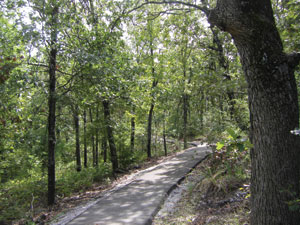 Recreation
is popular in this forest type because large portions of the state’s
population live within the Cross Timbers. Some recreational
activities include bird watching, swimming, canoeing, hiking, camping,
fishing, hunting, cycling, horseback riding, and Recreation
is popular in this forest type because large portions of the state’s
population live within the Cross Timbers. Some recreational
activities include bird watching, swimming, canoeing, hiking, camping,
fishing, hunting, cycling, horseback riding, and spiritual renewal. Cross Timbers is home to a wide variety of wildlife. Because of the habitat diversity – thick forests, prairie gaps, and even wetlands – the Cross Timbers harbors many different types of animals, from white-tailed deer to spotted skunks, from western chicken turtles to five-lined skinks, and scissor-tailed flycatchers to painted buntings. What is Being Done to Help the Cross Timbers? Oklahoma Forestry Services, Department of Agriculture, Food, and Forestry, and Oklahoma Natural Areas Registry are working with many partners to help educate landowners about the benefits of the Cross Timbers and how to manage this forest type to meet their objectives while conserving and enhancing nature’s benefits. 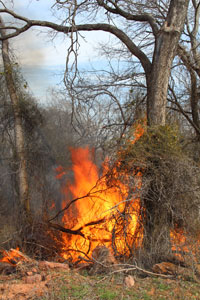 In
central Oklahoma, OFS has worked with Oklahoma State University to
study management options of Cross Timbers near Stillwater. OFS
also has worked with Oklahoma City and City of Sand Springs to conduct
prescribed burns to improve the health of the Cross Timbers surrounding
Lake Stanley Draper and the Keystone Ancient Forest. These will
be demonstration areas for anyone wanting to learn more about managing
Cross Timbers forests. OFS foresters are available to provide
technical assistance to any landowners interested in managing their
Cross Timbers. In
central Oklahoma, OFS has worked with Oklahoma State University to
study management options of Cross Timbers near Stillwater. OFS
also has worked with Oklahoma City and City of Sand Springs to conduct
prescribed burns to improve the health of the Cross Timbers surrounding
Lake Stanley Draper and the Keystone Ancient Forest. These will
be demonstration areas for anyone wanting to learn more about managing
Cross Timbers forests. OFS foresters are available to provide
technical assistance to any landowners interested in managing their
Cross Timbers.The ONAR encourages citizen-based conservation of Oklahoma’s natural diversity through a voluntary land preservation program. Several Registry sites protect ancient Cross Timbers. If you own land that you believe may have old-growth Cross Timbers, you may contact the Registry Program about becoming a member. How Can You Help the Cross Timbers? Think about the values provided by Cross Timbers. Once a forest is removed, it will take more than a lifetime to replace. Blend Cross Timbers conservation into your land-use plans and strive to retain, maintain, and protect where possible. Learn how to minimize the negative impacts from roads, grading, soil movement, and drainage. Manage your woodland intentionally to improve and restore forest health and resiliency:
|
Article Links
What Makes Up the Cross Timbers? A Little History of the Cross Timbers What is Happening to the Cross Timbers? Why Should the Cross Timbers Matter to you? What is Being Done to Help the Cross Timbers? How Can You Help the Cross Timbers? Additional Online Resources
Oklahoma Forestry Services Oklahoma Prescribed Fire Council Ancient Cross Timbers Consortium Oklahoma Natural Areas Registry Downloadable Full Text of Washington Irving's Travelogue A Tour on the Prairies Places to experience
Cross Timbers in Oklahoma |
